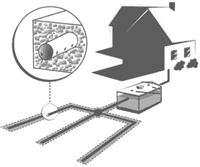How It Works
A septic tank system contain two major components: a septic tank and the absorption field. The septic tank is usually made of concrete, fiberglass or plastic and buried and watertight. All septic tanks should have baffles at the inlet and outlet to insure proper flow patterns. Most septic tanks are single compartments, but some states require multi-compartment tanks or two tanks in a series. A typical septic tank holds a 1000 gallons. The purpose of the septic tank is to separate the solids from the liquids and to promote partial breakdown of comtaminants by bacteria. The solids form a sludge that collects on the bottom of the tank and scum, floats on top of the water, remain in the tank and are pumped out periodically.
 The wastewater is distributed in the absorption field through the perforated pipes. The absorption field treats the wastewater through an aerobic digestion process and removes the remaining impurities (germs and chemicals) before the wastewater returns to the groundwater. The effluent wastewater coming out of the septic tank is cloudy liquid that still contains many diseases causing germs and pollutants. When this water flows into the perforated pipe in the absorption field, the effluent exits through the holes in the pipe and goes through the rock or gravel where it is stored until it is absorbed by the soil. As the effluent flows through the unsaturated soil, many of the bacteria that can cause diseases are filtered out. Some of the other smaller germs, such as viruses, are trapped and held by the soil until they die. The soil can also retain certain nutrients such as phosphorus and nitrogen.
The wastewater is distributed in the absorption field through the perforated pipes. The absorption field treats the wastewater through an aerobic digestion process and removes the remaining impurities (germs and chemicals) before the wastewater returns to the groundwater. The effluent wastewater coming out of the septic tank is cloudy liquid that still contains many diseases causing germs and pollutants. When this water flows into the perforated pipe in the absorption field, the effluent exits through the holes in the pipe and goes through the rock or gravel where it is stored until it is absorbed by the soil. As the effluent flows through the unsaturated soil, many of the bacteria that can cause diseases are filtered out. Some of the other smaller germs, such as viruses, are trapped and held by the soil until they die. The soil can also retain certain nutrients such as phosphorus and nitrogen.